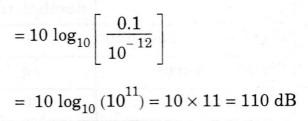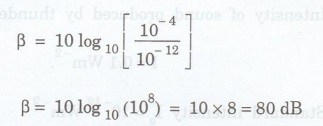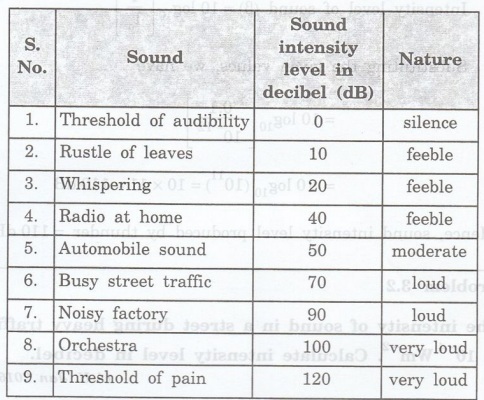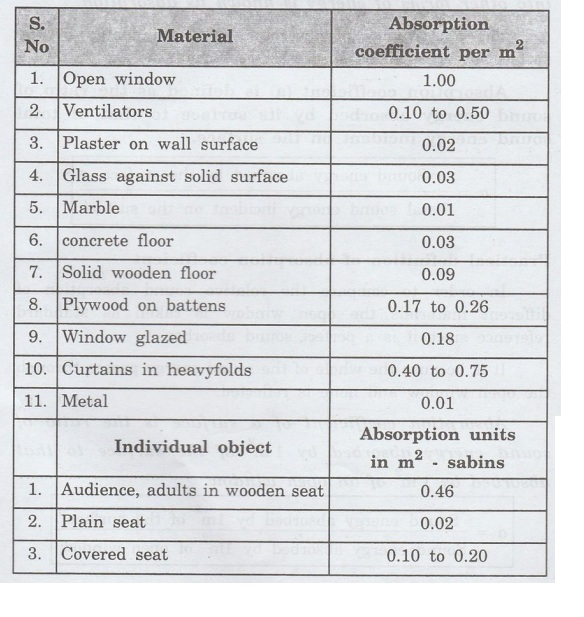Physics For Civil Engineering: Unit III: Acoustics and Lighting Designs
Solved Example Problems on Acoustics (intensity of sound, Decibel)
The intensity of sound produced by thunder is 0.1 Wm2. Calculate the intensity level in decibel.
ANNA UNIVERSITY SOLVED PROBLEMS
Problem 3.1
The
intensity of sound produced by thunder is 0.1 Wm2. Calculate the intensity
level in decibel.
Given
data
Intensity
of sound produced by thunder,
I = 0.1 Wm- 2.
Standard
intensity IO = 10-12 Wm-2
Solution
Intensity
level of sound (B) = 10 log10 [I/IO]
Substituting
the given values, we have

Hence, sound intensity level produced by
thunder = 110 dB
Problem 3.2
The
intensity of sound in a street during heavy traffic is 10-4 Wm-2.
Calculate intensity level in decibel.
Given data
Intensity
of sound in the street, I = 10-4 Wm-2
Standard
intensity of sound IO = 10-12 Wm-2
Solution
Sound
intensity level (ẞ) = 10 log10 [I/IO]
Substituting
the given values, we have

TABLE
3.1

Acoustics of buildings
The subject of physics which deals with the design
and construction of rooms or halls so as to give the best sound effects is
called acoustics of buildings or architectural acoustics.
The
acoustical properties of a room or halbi have considerable effect on the
clarity and intelligibility of speech or music produced in the hall.
The
acoustic properties quofis buildings were studied systematically by Prof.
Wallace C. Sabine, Professor of Physics in Harvard University, U.S.A in the
year 1900. ads audT
Now,
the science of acoustics of buildings has a prominent role in the design of
modern buildings.
Sound Absorption Coefficient
When a sound wave strikes a surface, a
part of its energy is absorbed, a part of it is transmitted and the remaining
part is reflected.
The property of the surface to
convert sound energy into other forms of energy is known as absorption.
The
effectiveness of absorption of sound energy by the surface is expressed as
absorption coefficient.
Absorption
coefficient (a) is defined as sound energy absorbed by its surface to that of
total sound energy incident on the surface.
α
= Sound energy absorbed by the
surfaces./ Total sound energy incident on the
surface
Practical definition of absorption
coefficient
In
order to compare the relative sound absorption of different materials the open
window is taken as standard reference since it is a perfect sound absorber.
It
is because the whole of the sound energy passes through the open window and
none is reflected.
Absorption coefficient of a surface
is the ratio of sound energy absorbed by 1m2 of the surface to that absorbed by 1m2 of an open window.
α
= Sound energy absorbed by 1m2
of the surface / Sound energy absorbed by 1m2 of open window
Clearly, the value of absorption
coefficient varies between 0 and 1. (1 is being the maximum value of absorption
coefficient).
Thus,
absorption coefficient is measured in Open Window Unit and is written as O.W.U.
or sabine/m m2.
For
example, absorption coefficient of plastered wall is 0.03 O.W.U. It means that
sound energy absorbed by 1 m2 of plastered wall is 0.03 times that
absorbed by 1 m2of an open window.
TABLE 3.2
Absorption
coefficients of some common sound You absorbing materials

Physics For Civil Engineering: Unit III: Acoustics and Lighting Designs : Tag: : - Solved Example Problems on Acoustics (intensity of sound, Decibel)
Related Topics
Related Subjects
Physics for Civil Engineering
PH3201 2021 Regulation | 2nd Semester Civil Dept 2021 Regulation
